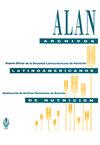体重指数参考。阿根廷学童肱脂肪区的诊断准确性
IF 0.3
4区 医学
Q4 NUTRITION & DIETETICS
引用次数: 0
摘要
体重指数(BMI)是检测儿童和青少年体重超负荷的有效工具,与身体肥胖有关。客观的分析三种国际BMI/年龄参考(世界卫生组织、IOTF和CDC)诊断超重的一致性、敏感性和特异性,并了解其诊断阿根廷儿童肥胖人群中与臂脂肪面积(BFA)相关的过度肥胖的准确性。材料和方法。2003年至2008年间,对22658名4至13岁的阿根廷儿童和青少年进行了一项多中心、描述性、比较性和横断面研究。根据体重、身高、臂围和三围计算BMI和BFA。分析了BMI/年龄参考(世界卫生组织、IOTF、CDC)的一致性、敏感性和特异性,以及从BFA和最佳临界点(OCP)确定过度肥胖的诊断精度(ROC曲线)。后果三个参考文献具有良好的一致性,最高的敏感性对应于世界卫生组织,最高的特异性对应于IOTF。男性的Z-BMI/IOTF和女性的Z-BMI/世界卫生组织的曲线下面积(AUC)更大。OCP显示出差异,与世界卫生组织相比更高。结论这三个参考文献显示了检测高热量储备的相似诊断准确性,但Z-BMI评分的截止点小于2Z评分。这与确定人群过度肥胖与实施预防慢性非传染性疾病的公共政策有关。本文章由计算机程序翻译,如有差异,请以英文原文为准。
Referencias de índice de masa corporal. Precisión diagnóstica con área grasa braquial en escolares argentinos
The body mass index (BMI) is an effective tool to detect weight overload in children and adolescents, associated with body adiposity. Objective. To analyze the concordance, sensitivity and specificity of three international BMI/age references (WHO, IOTF and CDC) to diagnose excess weight and to know their diagnostic accuracy to identify excess adiposity in relation to the brachial fat area (BFA) in Argentine child-youth population. Materials and methods. A multicenter, descriptive- comparative and cross-sectional study was carried out between 2003 and 2008 in 22.658 Argentine children and adolescents between aged 4 to 13 years. From the weight, height, arm circumference and tricipital fold, BMI and BFA were calculated. The concordance, sensitivity, and specificity of BMI / age references (WHO, IOTF, CDC,) were analyzed and the diagnostic precision (ROC curves) to identify excess adiposity, from the BFA, as well as the optimal cut-off point (OCP). Results. The three references had good agreement, the highest sensitivity corresponded to WHO and the highest specificity to IOTF. The area under the curve (AUC) was greater in Z-BMI/IOTF in men and in Z-BMI/WHO in women. The OCPs showed discrepancies, being higher with WHO. Conclusion. The three references show similar diagnostic accuracy to detect high caloric reserve, but with cut-off points for Z-BMI scores less than 2 Z scores. This is relevant for the identification of excess adiposity in populations in relation to the implementation of public policies for the prevention of chronic non-communicable diseases.
求助全文
通过发布文献求助,成功后即可免费获取论文全文。
去求助
来源期刊
CiteScore
0.50
自引率
0.00%
发文量
31
期刊介绍:
Archivos Latinoamericanos de Nutrición (ALAN) is the official publication of the Sociedad Latinoamericana de Nutición (SLAN), for the dissemination of knowledge in the fields of food and nutrition, principally throughout the American Hemisphere. Articles in Spanish, English, Portuguese and French are accepted, both from the Society members and from nonmembers, in the following categories: 1. General articles (critical scientific reviews); 2. Research articles (originals); 3. Papers in applied nutrition (analytical results from intervention programs and discussion of reconmendations of practical application), and 4. Letters to Editor (short comments of general interest or about scientific facts and results previously published in Archives).

 求助内容:
求助内容: 应助结果提醒方式:
应助结果提醒方式:


